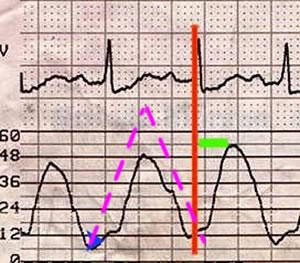|
The RV pressure rises as a result of isovolumetric contraction. During isovolumetric contraction, the RV pressure rises while all 4 valves remain closed. The RV pressure must increase until it becomes higher than the pulmonary artery pressure. This pressure difference is needed to open the pulmonic valve. The rise in RV pressure coincides with ventricular depolarization (QRS). Figure 1 shows an RV pressure tracing obtained from the tip of a pulmonary artery catheter (110 cm in length). Note that the RV rise appears slightly after the QRS due to the time required for the pressure to be reflected back to the transducer. If a sinus rhythm is pressent, a small rise in the ventricular pressure may be visible just before the upstroke of the ventricular pressure. This represents the ventricular filling associated with atrial contraction (identified by the blue arrow). Note the large difference between the systolic and diastolic pressures. The right ventricle and pulmonary artery pressures become equal when the pulmonary valve opens during systole. Consequently, the RV and PA pressures are equal during systole. The diastolic RV pressure is lower than the diastolic pulmonary artery pressure. It is the drop in the right ventricular diastolic pressure when compared to the pulmonary artery diastolic pressure that makes the right ventricular waveform "taller" than the pulmonary artery. Be aware that a change in scale can make a waveform look shorter or taller. Note the overall shape of the RV tracing. If you draw a line down the middle from the peak of the wave, it has a symmetrical and tombstone shape. There may be a wobble on the downstroke of the waveform, but there is no diacrotic notch. |
|
| Figure 1: Right Ventricle (RV) waveform measured from the tip of a Pulmonary Artery Catheter (PAC) | Figure 2: Pulmonary Artery (PA) waveform obtained from the tip of the Pulmonary Artery Catheter (PAC) |
|
When compared to the same patient's right ventricular waveform, the rise in the pulmonary artery tracing occurs later in relationship to the QRS (highlighted by the red line). The rise in the pulmonary artery pressure occurs after the ventricle contracts and blood is propelled into the pulmonary circuit. Remember, the RV pressure must rise first in order to open the pulmonary valve, the pulmonary artery pressure doesn't rise until after the valve has opened and the ventricle begins to contract. Compare the distance from the start of the QRS to the rise in the pressure waveform between the RV tracing (Figure 1), and this PA tracing (Figure 2). The systolic pulmonary artery pressure is very similar to the right ventricular systolic pressure. The diastolic pulmonary artery pressure is higher. If a pulmonary wedge pressure has been obtained, the PA diastolic pressure is close to the pulmonary wedge diastolic pressure (and higher than the right atrial pressure). The dicrotic notch (blue arrow) represents the closure of the pulmonic valve and the beginning of diastole. Compare the shape of the PA waveform to that of the RV waveform. Note that the PA rises quickly, but has a more graded downslope. Thus, the RV has a symmetrical up and down shape versus the PA with an asymmetrical slope. |
|
|
Brenda Morgan Revised January 14, 2019
|
|





